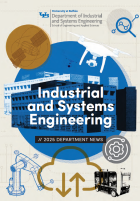UB elevates data and information fusion center to institute

The relaunch reflects UB researchers’ expertise in space defense, big data, automated decision making and cybersecurity
By Elizabeth Egan
Published March 7, 2024
The Center for Multisource Information Fusion, the University at Buffalo’s world-renowned academic research and development initiative, is elevating its research infrastructure and expanding its offering of academic programs.
The relaunched Collaborative Institute for Multisource Information Fusion (CIMIF) is uniquely positioned to leverage strategic partnerships with government, industry and academia to advance data fusion in support of intelligence, defense and homeland security.
"This one-of-a-kind interdisciplinary research institute will continue to drive innovation in information fusion and propel UB to the forefront of this rapidly progressing field," said Venu Govindaraju, vice president of research and economic development. "By expanding our robust research and academic programs in CIMIF, we will help advance national security and empower the next generation of innovative thinkers to make groundbreaking discoveries and boost the workforce in information fusion and defense technology."
Since its inception in 1996, CIMIF has remained the only dedicated multisource fusion institute in the United States and is one of only two in the world. Multisource information fusion is the analysis of information from multiple sources—such as sensors, human reports and databases—to produce more accurate estimations about an entity, activity or event.
Over the years, the institute has expanded its network to encompass several collaborative organizations. Among them, CUBRC, a nonprofit headquartered in Western New York dedicated to technology development and national defense, stands out as a key partner in CIMIF endeavors.
“Our institute is incredibly unique. No one else in the country does the work that we do,” said John Crassidis, CIMIF director and SUNY Distinguished Professor in the UB Department of Mechanical and Aerospace Engineering. “As an institute, we will be able to enhance the visibility and impact of our expanded research and educational initiatives."
The top technical areas of CIMIF are space defense, big data, automated decision making and cybersecurity. From working with the Navy to minimize the transportation of illegal items across maritime borders to conducting experiments with uncrewed aerial vehicles in UB’s open-air drone testing facility, the Structure for Outdoor Autonomy Research, the institute is engaged in a wide range of interdisciplinary research projects.
CIMIF has attracted significant funding from various organizations and government agencies, including from the Department of Defense (DoD). In 2022, CIMIF was one of two organizations nationwide chosen to lead the Space University Research Initiative. It received a five-year, $5 million research award from the U.S. Air Force Research Laboratory (AFRL) and partners that aims to improve the nation’s ability in tracking and monitoring spacecraft and other objects, such as debris and meteoroids.
The institute has also received funding from the AFRL to develop higher fidelity and actionable intelligence for space-based threats, and support from Northrop Grumman and the Office of Naval Research to build navigation solutions for uncrewed aircraft systems.
Several companies and universities work closely with the institute, as well as its 45 UB faculty members. Researchers are affiliated from a variety of disciplines across the UB School of Engineering and Applied Sciences and other fields, including geography, geology, mathematics, medicine and philosophy.
In 2009, James Llinas, research professor emeritus of industrial and systems engineering and director emeritus of CIMIF, led a multidisciplinary university research initiative (MURI)—a highly competitive research grant sponsored by the DoD—through the initiative, marking the first time that UB was the lead university for a MURI-supported research program.
As an institute, CIMIF is better positioned to stand at the forefront of data fusion research and education, strengthening UB’s ambition to become a top 25 public research university. The institute plans to explore developing a new “information fusion corridor” through a consortium of universities across New York. The UB Center for Space Cyber Strategy and Cyber Security, also directed by Crassidis, will transition under CIMIF, as well.
While much of the institute’s work is involved with defense, its researchers explore other fields, such as health care.
“We are involved with a project right now with DARPA [Defense Advanced Research Projects Agency], dealing with kidney transplantation,” said Moises Sudit, CIMIF executive director, professor in the UB Department of Industrial and Systems Engineering, and associate dean for research in the UB School of Engineering and Applied Sciences. “We are using data fusion models to maximize the utilization of kidneys from both volunteers and donors.”
Moises and Crassidis, also a Moog Professor of Innovation, will maintain their positions in CIMIF.
Robert Dell, professor in the UB Department of Industrial and Systems Engineering, will join CIMIF leadership as associate managing director. CIMIF will also add an associate director of education programs to its leadership team to oversee degree and credentialing programs.
CIMIF will offer an online master’s degree in data and information fusion and aims to develop a PhD program in the area as well. The institute will also provide information fusion courses to various companies and defense agencies.
These educational programs will strengthen the data and information fusion workforce, a field that has grown tremendously in the past two decades and that has an enormous impact on business, defense and society.
